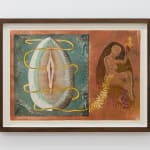Alexi Marshall
17 1/8 x 26 in.
Further images
The exhibition Nostalgia for the mud represents a primal desire to return to our roots, like the eel's journey through life phases in search of origin.
“Linocut painting” is a term coined by Marshall that describes the process of carving a linoleum sheet to create a relief design. Ink is applied to the remaining raised areas, and a print is made by pressing paper onto the inked surface. The artist does not use a printing press, instead, she relies on physical pressure to transfer the ink. This approach combines the precision of printmaking with the spontaneity and texture of painting, resulting in unique, unrepeatable prints. Unlike traditional painting, where changes can be made throughout the process, each decision in linocut is permanent.
Beginnings reflects on three types of beginnings: human life, the eel, and time itself. On the left side of this “lino painting” the artist presents a vulvic cosmic egg, an ancient symbol, encircled by four nymph-like figures that symbolise the four currents of the Sargasso Sea. An eel circles the egg, referencing the generative myth of Ananke, the feminine force who cracked open the egg, releasing the universe. Marshall represents Ananke’s essence of drive, necessity, compulsion, and fate, paralleling the eel's drive to complete its journey. Ananke, like the eel, is motherless and primordial. This scene unfolds within a womb-like space, where the eel morphs into an umbilical cord made of Sargasso seaweed, reminiscent of the womb, where all human life begins.









